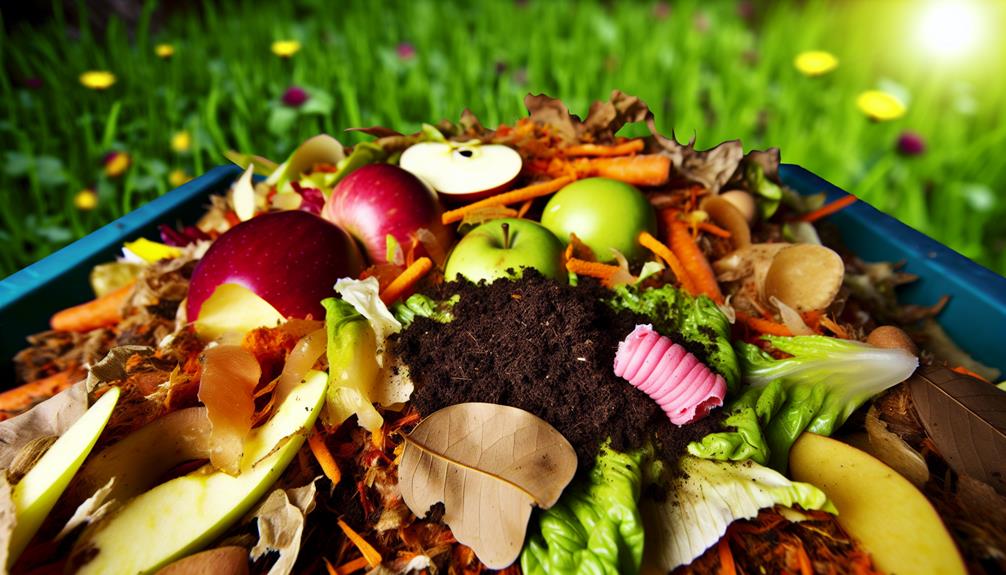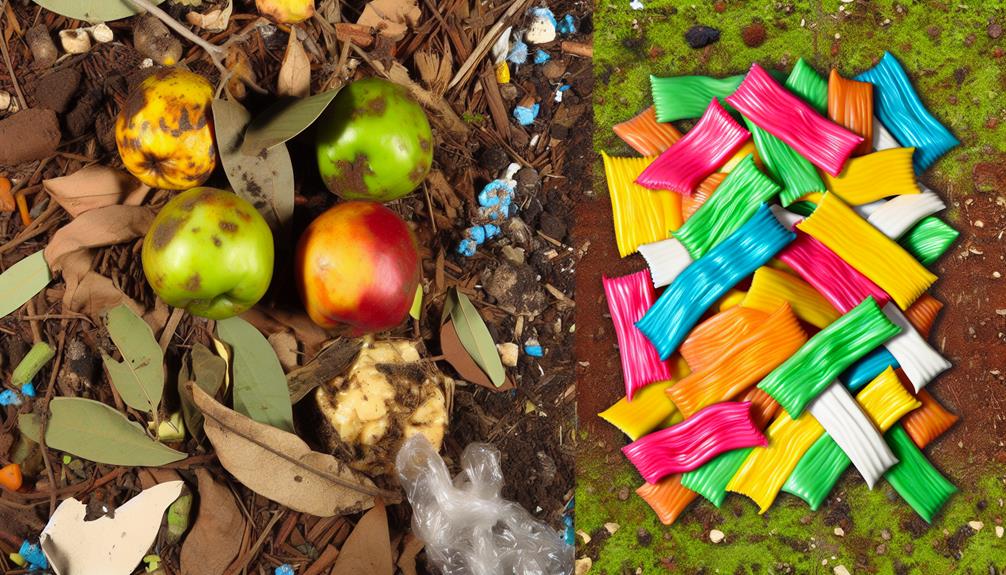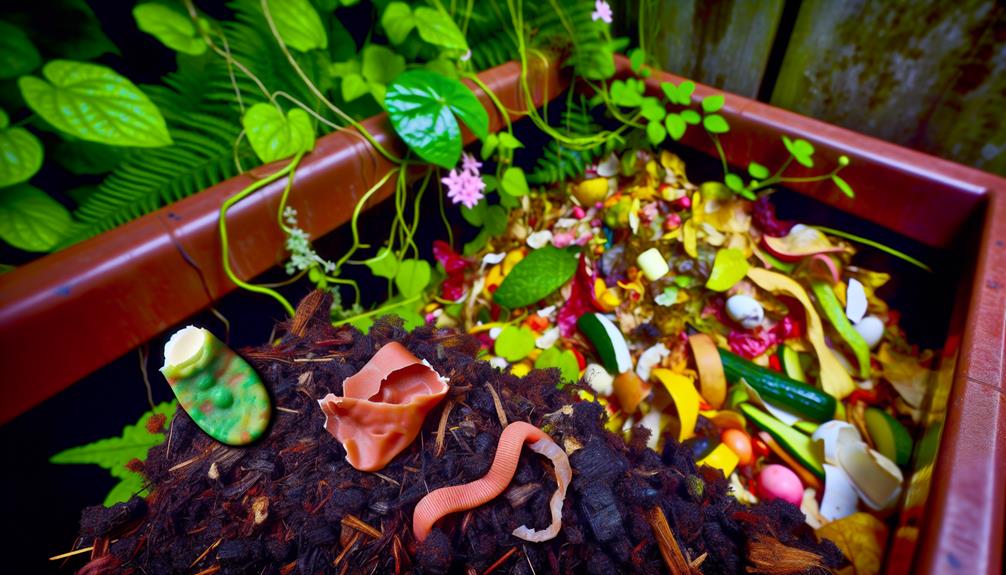

You can’t compost regular chewing gum because its synthetic rubber base doesn’t biodegrade. Most chewing gum contains synthetic polymers that don’t break down naturally. This means they wouldn’t decompose in your compost bin and could end up causing problems. Instead, wrap your used gum in paper and dispose of it in the trash.
Alternatively, look for biodegradable gums made from natural ingredients like chicle, which can break down more easily. Choosing these eco-friendly options and properly disposing of traditional gum helps reduce environmental impact. Want to explore more sustainable solutions? Keep on to discover additional eco-friendly alternatives.
Most people don’t realize the significant environmental impact caused by improperly disposed chewing gum. When you toss gum onto the street or park, it doesn’t just disappear. Chewing gum is made from synthetic rubber, a type of plastic that contributes to plastic pollution. This means it can take years to degrade, causing long-term damage to our environment.
Improperly disposed gum sticks to surfaces, creating an eyesore and a waste management nightmare. Cities spend millions annually scraping gum off sidewalks and public spaces. This not only wastes resources but also highlights the broader issue of plastic pollution.
When gum ends up in landfills, it adds to the growing pile of non-biodegradable waste, further straining waste management systems.
You can make a difference by disposing of your gum properly. Use trash bins, not the ground. Educating friends and family about the environmental impact of gum can also help. By understanding and addressing the issue, you’re joining a community that cares about reducing plastic pollution and improving waste management. Together, small actions can lead to significant environmental benefits.
Let’s work together to keep our surroundings clean and sustainable.
Also Read: Can You Compost Broad Beans?
When you compare biodegradable and non-biodegradable gum, you’ll notice significant differences in their ingredients and environmental impacts. Biodegradable gums use natural ingredients that break down more easily, reducing their environmental footprint.

Non-biodegradable gums, however, often contain synthetic polymers, making them persistent pollutants.
In choosing gum, you mightn’t realize the significant difference between biodegradable and non-biodegradable ingredients. Biodegradable gum uses eco-friendly ingredients, which break down naturally over time. Ingredients like chicle, a natural latex obtained from the sapodilla tree, are common in biodegradable gum. These ingredients guarantee that the gum doesn’t leave a lasting environmental footprint, aligning with your values of sustainability.
Non-biodegradable gum, on the other hand, often contains synthetic polymers, which are similar to plastic. These ingredients can take hundreds of years to decompose, contributing to long-term pollution.
If you’re looking to make environmentally conscious choices, opting for gum with sustainable packaging and natural ingredients can make a significant difference.
When shopping for gum, check the label for terms like ‘biodegradable’ or ‘natural chicle.’ Supporting brands that prioritize eco-friendly ingredients helps you contribute to a healthier planet.
Choosing biodegradable gum over non-biodegradable options directly impacts the environment by reducing pollution and waste. When you opt for biodegradable gum, you’re contributing to a cleaner planet. Non-biodegradable gum often ends up in landfills and can take years to break down, releasing harmful chemicals into the soil and water. On the other hand, biodegradable gum is made from natural ingredients that decompose more quickly, lessening the strain on waste management systems.
By choosing biodegradable gum, you also support recycling programs. Non-biodegradable gum is difficult to recycle and often ends up as litter. This litter can leach chemical waste into the environment, posing risks to wildlife and ecosystems. Biodegradable gum, however, aligns better with composting and recycling efforts, making it a more sustainable choice.
Additionally, using biodegradable gum helps reduce the overall environmental footprint. Non-biodegradable gum contributes to chemical waste that can pollute air and water sources. By making a conscious choice to chew biodegradable gum, you’re helping to minimize these negative impacts and promote a healthier planet.
Every small decision counts, and by choosing biodegradable gum, you’re making a positive difference.
Biodegradable gum breaks down through natural processes involving microorganisms, while non-biodegradable gum relies on chemical degradation that can take decades.
When you choose biodegradable gum, you’re opting for a product made from natural substances like chicle, which microorganisms can easily break down. This type of gum decomposes more quickly and integrates back into the environment without causing harm.
On the other hand, non-biodegradable gum is typically made from synthetic polymers, which are resistant to microbial activity. These synthetic materials, combined with flavor additives, make the gum more durable and long-lasting, but also much harder to decompose.
Over time, chemical degradation slowly breaks these materials down, but it takes years, sometimes even decades, for this process to complete.
Understanding the difference helps you make more eco-friendly choices. If you’re aiming for a sustainable lifestyle, look for biodegradable options. These choices not only reduce waste but also support a cleaner environment.
Always check the packaging or product descriptions to make sure you’re getting gum that aligns with your environmental values. Making small changes like this can have a significant impact on reducing long-term waste.
To start composting, you need to understand how organic materials break down. Begin by layering green and brown materials, such as fruit scraps and dry leaves, to create a balanced compost pile.
Common compostable items include:
Understanding how organic materials break down is essential for effective composting. When you compost, you’re harnessing natural processes like enzymatic activity and microbial decomposition to convert organic waste into nutrient-rich soil.
Enzymes, which are proteins produced by microorganisms, break down complex organic molecules into simpler compounds. This makes it easier for microbes to further decompose the material.
In a successful compost pile, billions of microorganisms such as bacteria, fungi, and actinomycetes are hard at work. They rely on a balanced mix of green materials (rich in nitrogen) and brown materials (rich in carbon) to thrive. These microbes need oxygen and moisture to break down organic matter efficiently. If you want to be part of a community committed to sustainability, paying attention to these factors is key.
You’ll notice that some materials break down faster than others. Kitchen scraps and green yard waste decompose quickly, while wood and paper take longer. The size of the material also affects the rate of decomposition—smaller pieces break down faster.
When you start composting, it’s important to follow a few simple steps to make sure the process runs smoothly and efficiently. First, choose the right composting bin for your needs. You’ll want something with proper ventilation that can retain heat. Next, layer your compost materials in a balanced mix of greens (nitrogen-rich items) and browns (carbon-rich items). This balance helps maintain the ideal composting temperature, which should be between 135°F and 160°F.
To help you visualize this, here’s a quick table:
| Step | Description |
|---|---|
| 1. Choose a Bin | Select a bin with good ventilation. |
| 2. Layer Materials | Alternate between greens and browns. |
| 3. Monitor Temp | Keep the bin between 135°F and 160°F. |
| 4. Turn the Pile | Aerate by turning every few weeks. |
After setting up your bin and layering your materials, regularly monitor the composting temperature. If it drops too low, add more greens; if it gets too high, incorporate more browns. Turning the pile every few weeks ensures proper aeration, which is essential for efficient decomposition.
By following these steps, you’ll create a thriving compost system that breaks down organic materials effectively. Remember, the key is to maintain balance and monitor progress regularly.
When composting various items, it’s important to know which ones break down effectively and contribute to a healthy compost pile. Common compostable items are those that decompose naturally and provide valuable nutrients to your compost.
Here are a few key items you should definitely include:
Fruit peels are a great source of nitrogen and break down relatively quickly, enriching your compost with essential nutrients. When adding fruit peels, make sure to cut them into smaller pieces to speed up the composting process.
Vegetable scraps are another excellent addition. They decompose easily and offer a rich source of organic matter, balancing the carbon-to-nitrogen ratio in your pile.
Coffee grounds are highly beneficial for composting. They add nitrogen, promote microbial activity, and help keep the compost balanced. Used coffee grounds can be sprinkled directly onto the compost pile or mixed with other compostable materials.
Also Read: Can You Compost Branches?
Many people wonder if chewing gum can break down in compost, given its synthetic ingredients. Chewing gum typically contains synthetic polymers, which are designed to be resilient and long-lasting. Unfortunately, these synthetic polymers don’t easily undergo microbial degradation.
Microorganisms in compost piles can break down natural materials like food scraps and yard waste, but they struggle with synthetic substances like those found in gum.
When you add gum to your compost, it won’t decompose at the same rate as other organic materials. The synthetic polymers in gum resist the efforts of microbes, meaning the gum remains largely intact. This creates a challenge for those looking to maintain a pure, efficient compost system.
To make sure your compost pile remains effective, avoid adding chewing gum. Stick to materials that microbes can easily decompose, such as fruit peels, coffee grounds, and plant clippings. By doing so, you’ll foster a healthy compost environment where organic matter can break down efficiently.
Understanding the limitations of microbial degradation with synthetic polymers helps you make informed choices about what belongs in your compost. This knowledge guarantees your composting efforts are successful and environmentally friendly.
Since gum doesn’t break down well in compost, consider alternative disposal methods to manage your waste responsibly. By doing so, you can contribute to a cleaner environment and guarantee that your waste is handled efficiently.
First, check if there are any local recycling programs that accept chewing gum. Some cities have specialized facilities that can process gum waste into new products. This not only reduces landfill waste but also supports recycling initiatives.
Secondly, if recycling programs aren’t available, consider landfill alternatives. You can dispose of gum in regular trash, but make sure it’s wrapped in a piece of paper to prevent it from sticking to other items. This simple step makes waste management easier for sanitation workers.
Lastly, get involved in community clean-up efforts. Participating in local initiatives helps keep public spaces clean and raises awareness about responsible waste disposal.
Look for local recycling programs that accept gum.
Wrap gum in paper before disposing of it in the trash.
Join community clean-up efforts to promote responsible disposal.
Several sustainable chewing gum options are available that are both eco-friendly and biodegradable. You can find gum brands that use natural flavors derived from real fruits and plants, making your chewing experience more enjoyable and environmentally responsible.
Look for products that avoid synthetic ingredients and instead use natural sweeteners like xylitol or stevia.
When choosing sustainable gum, pay attention to the packaging. Many eco-friendly brands use recyclable or compostable materials, reducing waste and promoting a greener lifestyle. Eco friendly packaging not only helps the environment but also aligns with your values of sustainability.
Some popular brands include Simply Gum and Glee Gum, which use chicle—a natural gum base harvested from sustainably managed forests. These brands focus on minimizing their environmental impact while offering a satisfying chew.
One effective way to reduce gum waste is by properly disposing of your gum in a trash bin instead of spitting it onto the ground. This small action helps keep public spaces clean and reduces environmental pollution.
But there are other ways you can contribute to waste reduction and gum recycling.
Also Read: Can You Compost Arugula?
Ultimately, composting gum isn’t straightforward due to its synthetic ingredients, but understanding the options available can guide you toward more sustainable choices. Traditional gum contains plastics that don’t break down in compost. This makes gum recycling a better option for managing waste effectively.

First, consider participating in gum recycling programs. Some companies collect and recycle gum into new products. This not only reduces waste but also supports innovative waste management solutions.
Here’s a quick comparison to help you decide:
| Option | Benefits |
|---|---|
| Composting | Natural, but not effective |
| Gum Recycling | Reduces waste, innovative |
| Regular Disposal | Easy, but wasteful |
Second, look for biodegradable gum options. These alternatives are made from natural ingredients like chicle, which can be composted. Switching to biodegradable gum reduces your environmental footprint and makes composting more feasible.
Lastly, always be mindful of where you dispose of your gum. Improper disposal contributes to litter and environmental harm. By choosing gum recycling or biodegradable options, you contribute to better waste management and a cleaner environment. Remember, small changes in our daily habits can collectively make a significant impact.
In a landfill, gum decomposition can take decades or even centuries. Its environmental impact is significant, contributing to persistent waste. You’re making a difference by being mindful of proper disposal and encouraging sustainable habits in your community.
If animals accidentally ingest chewing gum, their digestion struggles with it. Gum isn’t easily broken down and can cause blockages. Be mindful of where you dispose of it to keep our furry friends safe.
Yes, there are health risks. The chemical composition of gum can disrupt microbial activity in your compost. You don’t want to harm your garden’s ecosystem. Stick to compostable materials to keep everything thriving.
To remove gum stuck to compostable materials, try the freezing method: place the item in the freezer until the gum hardens, then scrape it off. Alternatively, use a vinegar solution to dissolve the gum. You’re not alone in this!
Yes, you can recycle used chewing gum into other products. Recycling options depend on the gum ingredients. Some companies turn gum into rubber-based items, reducing waste and helping you contribute to a sustainable community.
